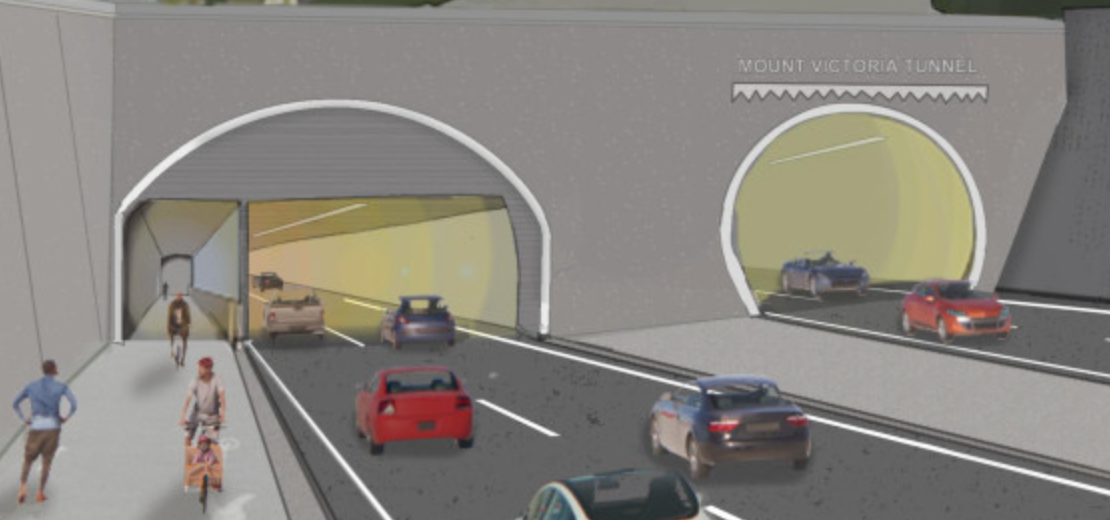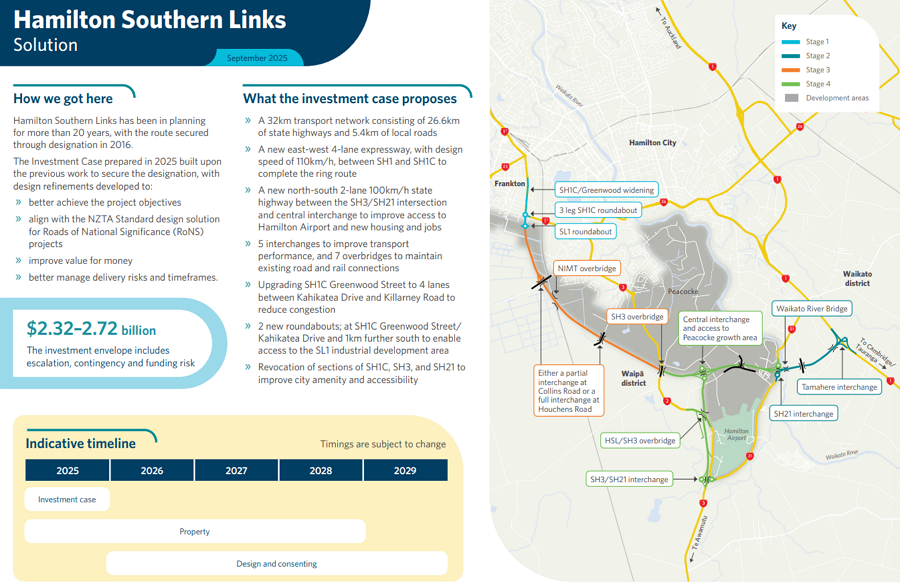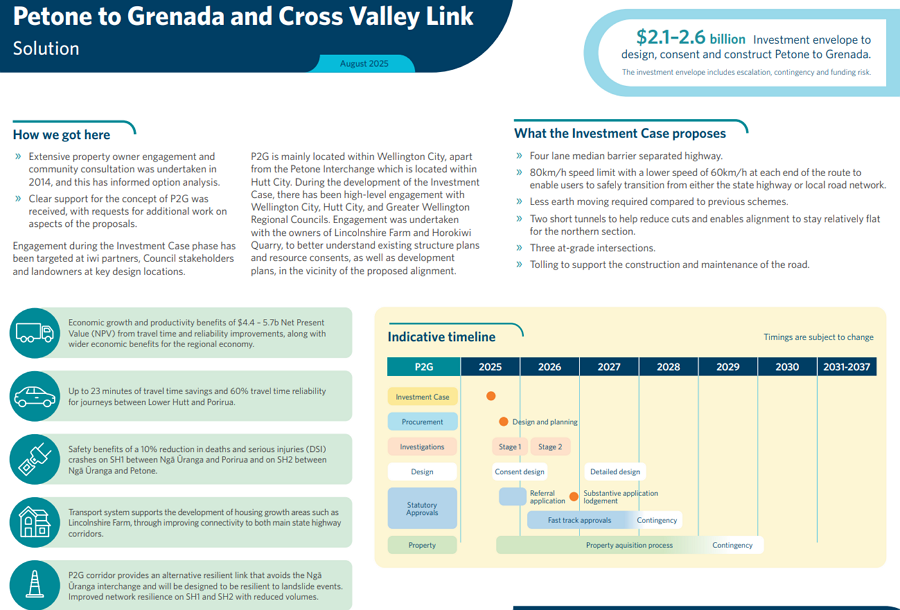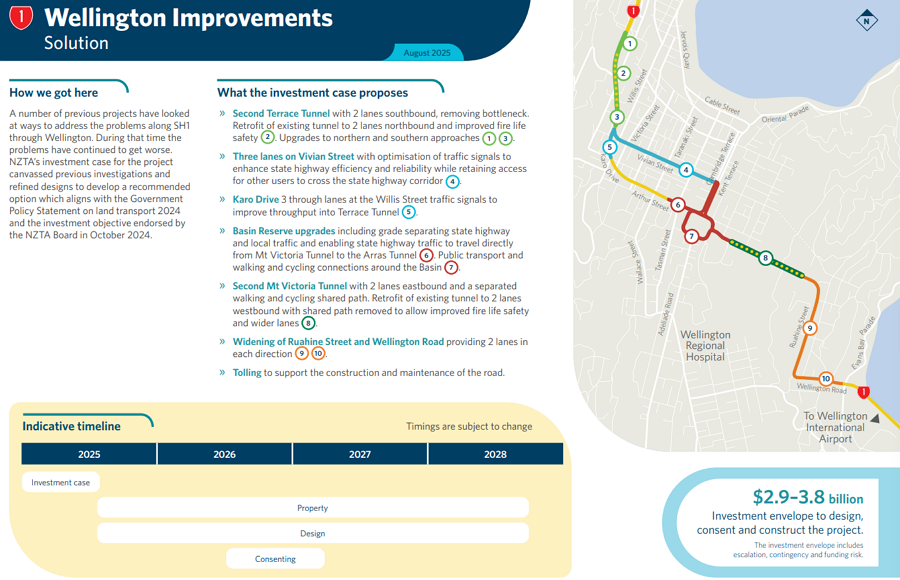The government’s mega-roads programme is now looking to cost an astonishing $40-50 billion, based on new documents released yesterday by the NZTA.
On Monday, Transport Minister Chris Bishop touted the fact that $1.2 billion would be spent towards funding for design, consenting and property acquisition for six of the projects.
At the same time, NZTA published some very high-level summaries (here) – which include some interesting details on the latest thinking about the Roads of National Significance (RoNS) programme.
“The NZ Transport Agency (NZTA) Board has now endorsed investment cases for all of the RoNS, with the most recent endorsements including Sections 2 and 3 of the Northland Expressway, the East West Link, Hamilton Southern Links, Petone to Grenada and Cross Valley Link, SH1 Wellington Improvements including a new Mt Victoria tunnel, and the Hope Bypass. These investment case summaries have now been published on NZTA’s website.
“The Board has also approved more than $675m in funding to progress consenting, design, route protection, site investigations, and some early works. In addition, more than $515m is expected to be used from approved RoNS property funding to enable local property acquisition to get underway on these projects.
“The NZTA Board’s endorsement of these investment cases, and approval of funding for next steps, ensures progress on these projects can continue at pace.
A striking thing about the RoNS investment cases is that all six of the projects now have Benefit Cost Ratios greater than one. In other words, the assertion is that (at least in theory) every dollar they cost will generate slightly more than that in benefits.
But this is only due to a significant change in the way NZTA calculates the BCR. Most notably:
these projects are now being assessed over a far longer period of time (up to 60 years instead of 30), andusing a much lower discount rate (2% dropping down to 1.5% after 30 years, whereas it used to be 6%).
This means projects that previously barely qualified as economical now suddenly generate more benefits than costs – and all now magically clear the (very low) hurdle of a BCR of 1.0.
There was a time when a BCR of 3.0 was the minimum for spending public funds on this scale.
Which raises the question: what should the bar be for funding these mega-projects, given that even with some creative accounting, so many examples are still only just scraping over it?
What can New Zealand actually afford to build? And why is this Government so determined to push the envelope (and lower the bar)?
Recall that last year the Infrastructure Commission/ Te Waihanga sounded a warning about the costs of the RoNS programme, which noted that one RoNS alone (the Northern Expressway) was set to soak up fully 10% of the nation’s infrastructure budget for the next 25 years – not only for roading, but for all infrastructure, including schools, hospitals, justice, defence, administration and more.
So, let’s take a look at the six RoNS whose business cases were endorsed yesterday, as they help to illustrate the scale of the unaffordability crisis racing towards us. It’s hard to avoid the conclusion that the Government is not just kidding themselves, they’re trying to fool the public as well.
Northland Corridor
This was always going to to be the most expensive of the projects, with reporting last year that it could consume 10% of all government infrastructure spending over the next 25 years.
See our earlier post: The Government’s Northern Expressway Obsession.
Even so, the numbers are staggering. The section between Whangarei and Te Hana is expected to cost $15.3-18.3 billion, and this doesn’t include the cost of the Warkworth to Te Hana section which is expected to start construction next year and was most recently estimated to cost $2.9-3.8 billion.
Combined, that’s $18.2-22.1 billion – which is incredible for a road that for most of its length carries only 10-15,000 vehicles a day.
To put the cost a different way: if usage of the road more than doubled to 30k vehicles per day (which is more than most parts of the Waikato Expressway) over a 30 year span, that would still work out at nearly $70 per trip include the cost of operating and maintaining the road.
The investment case claims that it will be up to 38 minutes faster to drive between Te Hana and Whangarei, and that the road reduce deaths and serious injuries by 66%. As a result – and with the much easier economic assessment method – they claim the project now has a BCR of 1.4.
 Yesterday’s announcement included this detail:
Yesterday’s announcement included this detail:
Funding of $187m to progress design, consenting, and route protection, with priority given for an alternative to the Brynderwyn Hills (section 2b)
East West Link
Just in time for Halloween, the zombie East West Link project is back from the dead – in a new slimmed down form, yet still significantly more expensive than it was nearly a decade ago.
A key change to the project is that it is no longer planned as a highway across the edge of the harbour. Rather, the proposal is now for some more sensible improvements to interchanges, and looking to make better use of Neilson St – which is something that should always have been part of the project.
One of the reasons noted below for the change is to reduce the environmental impact by avoiding the foreshore area.
Back in 2017, this project was expected to cost $1.8 billion – which at the time qualified it as the world’s most expensive road per kilometre. That’s now up to $3.7-4.1 billion.
The new East West investment case claims it will boost GPD by $49.5 million a year, which doesn’t sound like all that much for up to $4 billion in investment. Nonetheless, it’s claimed to have a BCR of 3.2 if untolled, or 2.6 if tolled. The following benefits are also provided for the project:
 Based on the above map, it seems it might still include this part at the Onehunga end – but without the foreshore extension:
Based on the above map, it seems it might still include this part at the Onehunga end – but without the foreshore extension:
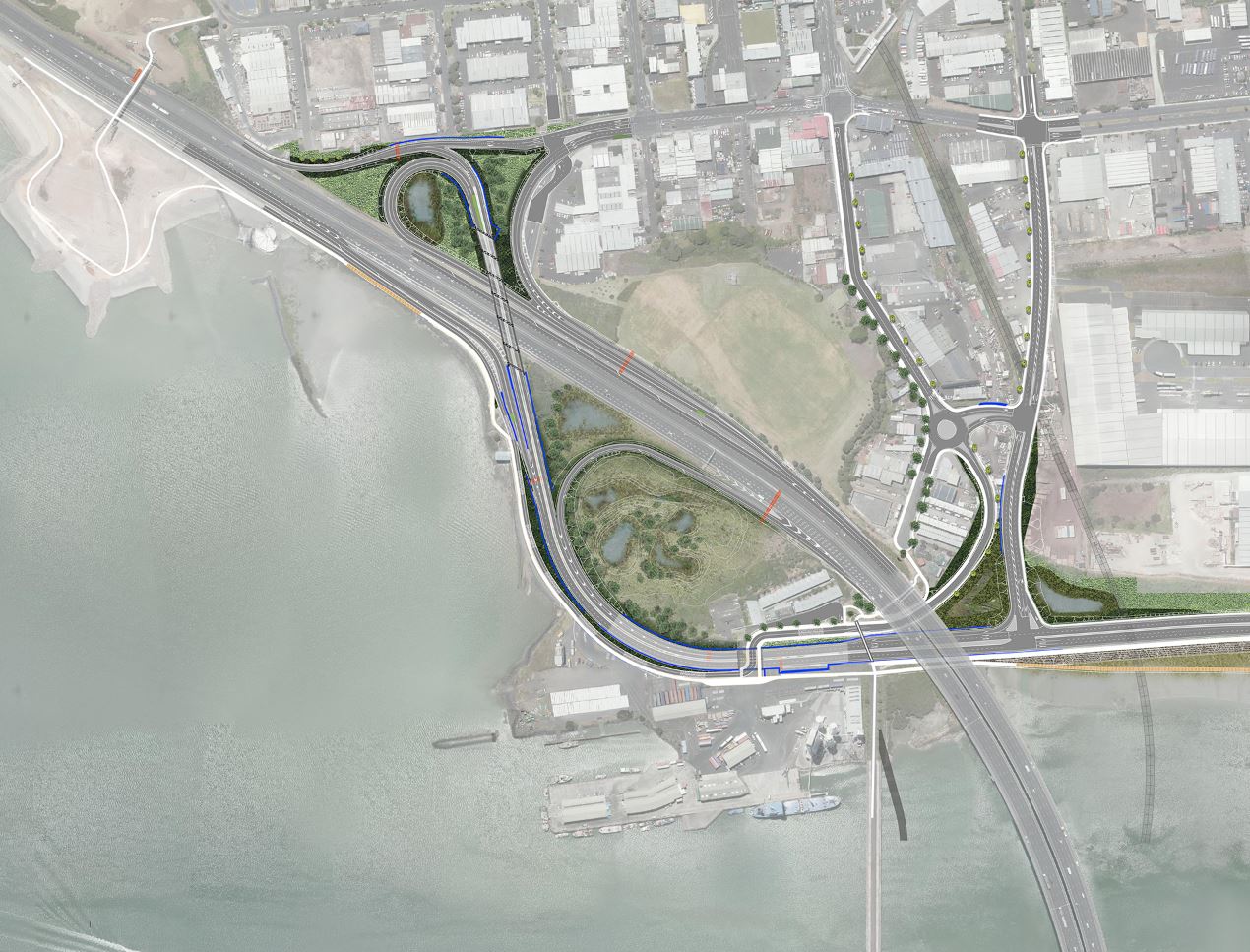 It’s also possible some parts of this structure – connecting Sylvia Park Rd back towards Onehunga – might still be on the cards.
It’s also possible some parts of this structure – connecting Sylvia Park Rd back towards Onehunga – might still be on the cards.
Yesterday’s funding announcement on preparatory work includes this for the East West link:
Funding of $102m to progress design, consenting and route protection.
Hamilton Southern Links
Hamilton has just been successfully bypassed, so clearly it’s time for another highway – this time with the stated goal of opening up more land for development.
The project will see what is now SH1C extended further south, eventually back to a new connection with the Waikato Expressway. The wider project also encompasses a number of local roads, including the new bridge over the Waikato that was opened last year to serve the new suburb of Peacocke.
Just like the East West Link, this project is expected to cost $3.7-4.1 billion for the following benefits:
By 2055, it will also support access to 17,300 new houses and 7,100 new jobs. The BCR is 1.9 un-tolled, 1.6 tolled, and 2.3 with WEBs included.
The funding announcement included this:
Funding of $100m to progress design, consenting and significant site investigations work.
Petone to Grenada and Cross Valley Link
These two projects seem very close to the Minister’s heart, as both are in his electorate. From yesterday’s announcement:
“The investment case for Petone to Grenada has confirmed a preferred and viable route, with travel time savings at peak of up to 23 mins between Lower Hutt and Porirua. The project also supports planned housing growth of more than 30,000 houses in Tawa, Porirua, and Hutt City. The BCR is 1.7 tolled/un-tolled, and 2.7 including WEBs. CVL has an incremental BCR of 2.0 assuming P2G is built first.
“The preferred route provides a more efficient connection with 70 per cent less earth works than previous designs, resulting in lower costs and less impact on communities.
The cost given is $2.1-2.6 billion, but it’s unclear if that’s for both projects, or just Petone to Grenada,
The announcement included:
Funding of $32m to progress design, consenting and procurement activities.
SH1 Wellington Improvements
The plans for a second Terrace tunnel and second Mt Victoria tunnel were confirmed last year after the investigations into a “long tunnel” option.
Now we finally know the cost of these and related changes. All up, this is expected to cost $2.9-3.8 billion – and notably, it has the lowest BCR of the six projects released – 1.0 if tolled, and 1.2 untolled.
“The investment case shows a good case for investment with strong benefits. It makes the best use of the existing SH1 tunnels and roading assets across the city, while also building much needed new capacity, flexibility, and resilience into the corridor. If tolled, the BCR is 1.0 including WEBs, and un-tolled the BCR is 1.2.
“Benefits include future travel times from the Wellington region to the central city, hospital, and airport reducing by up to 10 mins at peak times, travel time variability reducing by up to 40 percent, a 20 percent reduction in peak traffic on the Harbour Quays enabling increased use of buses, and an estimated 200 additional walking and cycling trips per day through the second Mt Victoria Tunnel.
This is what’s currently proposed for the Mt Victoria tunnel
“Walking and cycling between the eastern suburbs and the central city will also be safer with a new 3.6m wide enclosed shared path included in the second Mt Victoria Tunnel. The 1.4m raised path in the existing tunnel will be demolished to enable wider vehicle lanes and improved fire safety measures.
It’s great that Wellingtonians walking and biking will have a dedicated space, compared to the narrow and fume-laden path in the existing tunnel. But could we not squeeze an extra metre and a bit of width to enable separation of walkers and faster-moving people on bikes? Especially given the sums involved.
From the funding announcement:
Funding of $185m to progress design, consenting, and early works development.
Hope Bypass
Last on the list, and one of only two RoNS projects in the South Island, is the Hope Bypass in Richmond. Note that the project as proposed doesn’t actually bypass Hope (which is slightly further south along SH6).
“Delivering the first two stages has strong benefits, with a reduction in peak travel times through Richmond by up to 16 mins, support for 11,000 new homes and a reduction of up to two injury crashes per year. The project will also retain cycleway routes and connections. If tolled, the BCR is 1.1, un-tolled it is 1.7.
The project is only around 4km long but is expected to cost $1.1-1.4 billion.
The announcement included:
Funding of $72.6m to progress design, consenting and procurement activities.
All up, that’s $27.4-32.9 billion planned to be spent on the six RoNS projects in yesterday’s announcement.
Combined with some of the costs already announced for other projects, it brings the total for this package up to $40-50 billion. And this still doesn’t include all the other RoNS on the government’s wishlist.
That’s why this line from Bishop’s press release is perhaps the most important:
“It’s important that we also have a clear plan for delivery, including well-reasoned prioritisation to inform the order in which these RoNS are funded and delivered. The Government will have more to say about that in the coming months.
There it is. They know they can’t deliver all of these projects, but they want to pretend they still can. It will be interesting to see how long they keep up this game.
Especially now, in this economy – knowing that even building just half of these mega-roads will suck an enormous amount of public capital away from being able to build schools, hospitals, or anything else our nation urgently needs.
It seems that whatever the question, this government’s answer is “More RoNS”. But more RoNs will bankrupt the nation.
This post, like all our work, is brought to you by the Greater Auckland crew and made possible by generous donations from our readers and fans. If you’d like to support our work, you can join our circle of supporters here, or support us on Substack!
Share this

